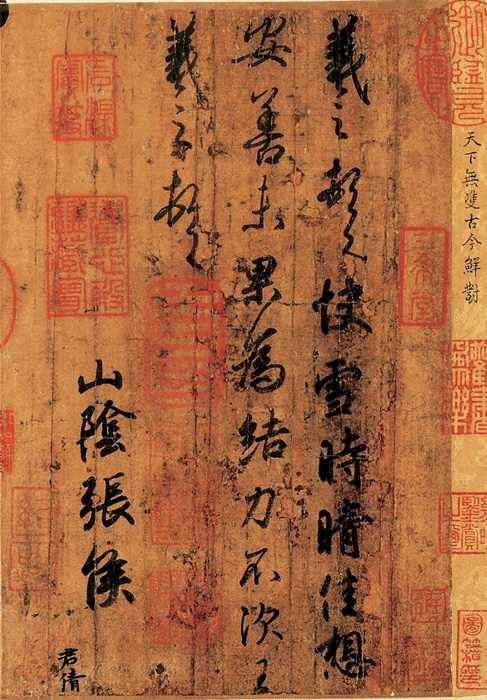Home >> Art >> Calligraphy >> Masters >> Wang Xizhi >> Timely Clearing After Snowfall
Timely Clearing After Snowfall (快雪時晴帖)
Wang Xizhi (王羲之, ca. 303-361), Jin Dynasty (265-420)
Album leaf, ink on paper, 23 x 14.8 cm, National Palace Museum, Taipei
Wang Xizhi, style name Yishao (逸少), was a native of Linyi (临沂) in Langya (琅琊, Shandong Province) and a member of the nobility. At the end of the Western Jin (265-316), he accompanied his father in moving south. During his career, he held various official positions. In 351, he was appointed as General of the Right Army and Administrator of Kuaiji (會稽). Sometime between 355 and 356, he chose to resign from all positions and joined other figures of renown on scenic excursions. Wang Xizhi was versed in poetry, music, and calligraphy. In the latter, he studied the works of all the masters past and present, frequently changing his models and expanding his repertoire in the process. He was especially gifted in the study of script forms. He took different brush styles, such as Qin dynasty (221-206 BC) seal script and Han dynasty (206 BC-220 AD) clerical script, and fused them into standard, running, and cursive scripts to create ideal calligraphy forms. Therefore, later generations in the Tang dynasty (618-907) praised him as "taking the best of all styles and compiling them into one to become the master of all time (兼撮眾法,備成一家,為萬世宗師)." For this reason, he became known as the "Sage Calligrapher".
In this short letter written in running script, Wang Xizhi sends greetings to a friend after a snowfall. The Ming dynasty connoisseur Zhan Jingfeng (詹景鳳, 1520-1602) pointed out that the round, forceful, elegant nature of the brushwork here has a leisurely spirit that influenced the running script of Zhao Mengfu (趙孟頫, 1254-1322), an influential calligrapher and painter of the Yuan dynasty. Much of the brushwork appears round and blunt, the dots and hooked strokes not revealing the tip of the brush. The characters are even and balanced, revealing a straightforward elegance and introverted harmony. The Qianlong Emperor (reigned 1735-1796) in the Qing dynasty especially prized this work, praising it as "The one and only; a masterpiece for all time (天下無雙,古今鮮對)." In 1747, he had it and "Mid-Autumn (中秋帖)" by Wang Xianzhi (王獻之) and "Boyuan (伯遠帖)" by Wang Xun (王珣) housed in a special room - "The Three Treasures Hall (三希堂)". This work is nowadays generally considered to be an excellent copy made in the Tang dynasty. None of Wang Xizhi’s original handwriting has survived.

Transcription: 羲之頓首 快雪時晴 佳想安善 未果為结 力不次 王羲之頓首 山陰張侯
Full Scroll with Inscriptions:
